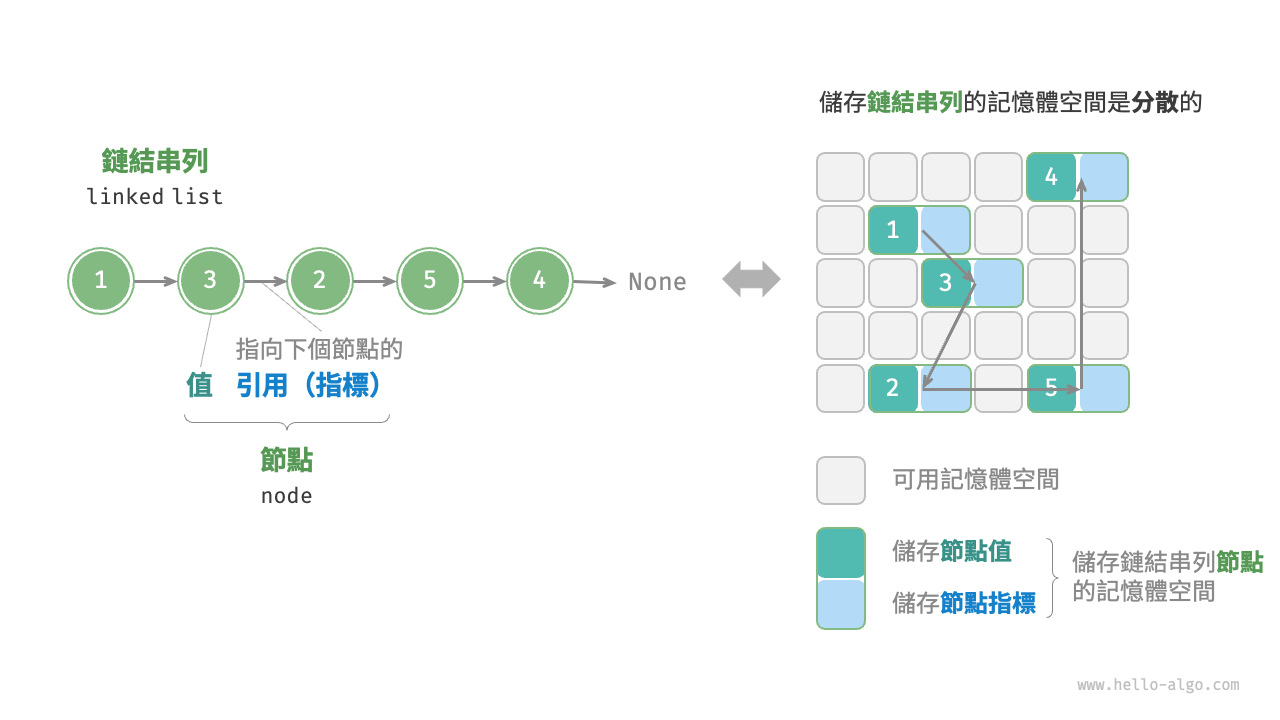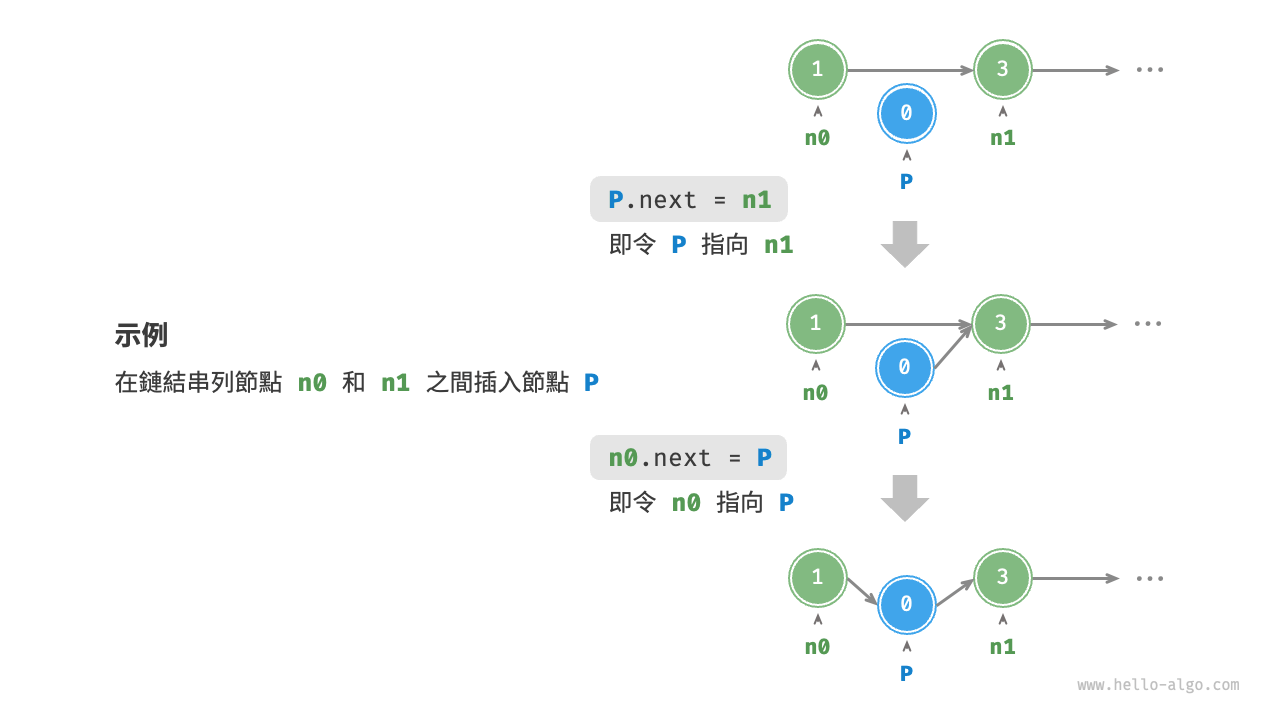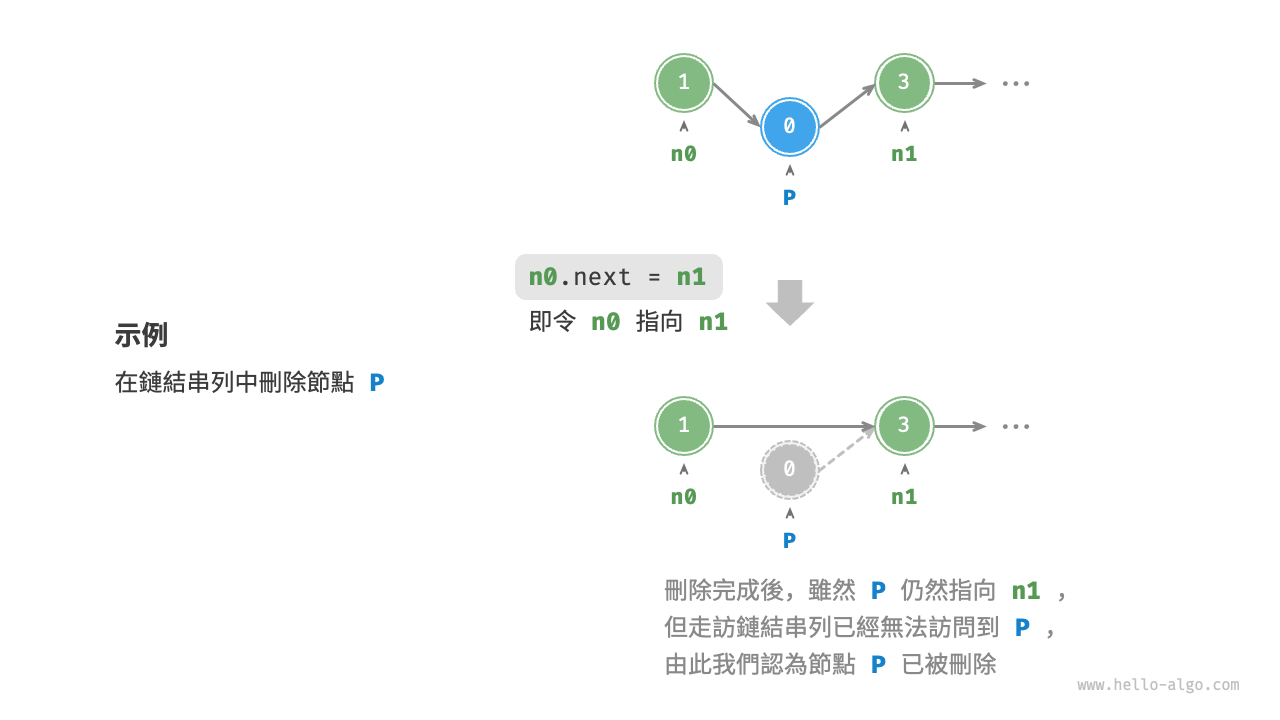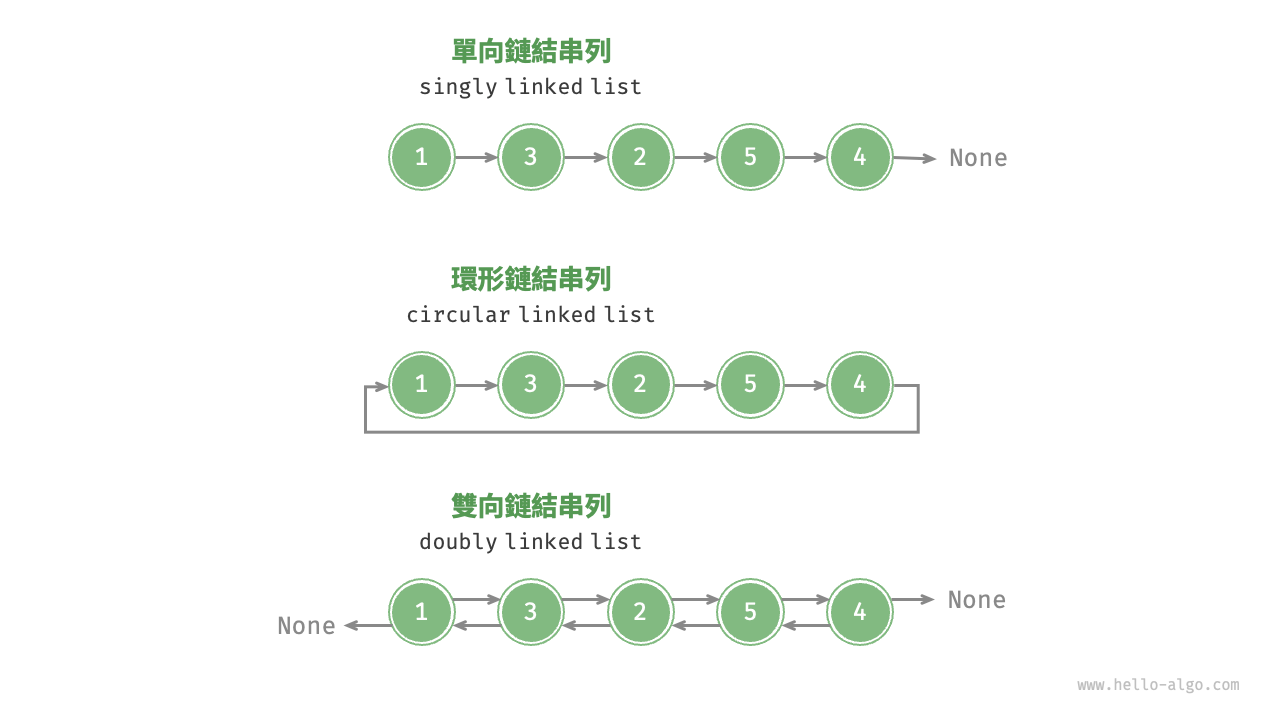4.2 鏈結串列
記憶體空間是所有程式的公共資源,在一個複雜的系統執行環境下,空閒的記憶體空間可能散落在記憶體各處。我們知道,儲存陣列的記憶體空間必須是連續的,而當陣列非常大時,記憶體可能無法提供如此大的連續空間。此時鏈結串列的靈活性優勢就體現出來了。
鏈結串列(linked list) 是一種線性資料結構,其中的每個元素都是一個節點物件,各個節點透過“引用”相連線。引用記錄了下一個節點的記憶體位址,透過它可以從當前節點訪問到下一個節點。
鏈結串列的設計使得各個節點可以分散儲存在記憶體各處,它們的記憶體位址無須連續。
圖 4-5 鏈結串列定義與儲存方式
觀察圖 4-5 ,鏈結串列的組成單位是節點(node) 物件。每個節點都包含兩項資料:節點的“值”和指向下一節點的“引用”。
鏈結串列的首個節點被稱為“頭節點”,最後一個節點被稱為“尾節點”。
尾節點指向的是“空”,它在 Java、C++ 和 Python 中分別被記為 null、nullptr 和 None 。
在 C、C++、Go 和 Rust 等支持指標的語言中,上述“引用”應被替換為“指標”。
如以下程式碼所示,鏈結串列節點 ListNode 除了包含值,還需額外儲存一個引用(指標)。因此在相同資料量下,鏈結串列比陣列佔用更多的記憶體空間 。
Python C++ Java C# Go Swift JS TS Dart Rust C Kotlin Ruby Zig
class ListNode :
"""鏈結串列節點類別"""
def __init__ ( self , val : int ):
self . val : int = val # 節點值
self . next : ListNode | None = None # 指向下一節點的引用
/* 鏈結串列節點結構體 */
struct ListNode {
int val ; // 節點值
ListNode * next ; // 指向下一節點的指標
ListNode ( int x ) : val ( x ), next ( nullptr ) {} // 建構子
};
/* 鏈結串列節點類別 */
class ListNode {
int val ; // 節點值
ListNode next ; // 指向下一節點的引用
ListNode ( int x ) { val = x ; } // 建構子
}
/* 鏈結串列節點類別 */
class ListNode ( int x ) { //建構子
int val = x ; // 節點值
ListNode ? next ; // 指向下一節點的引用
}
/* 鏈結串列節點結構體 */
type ListNode struct {
Val int // 節點值
Next * ListNode // 指向下一節點的指標
}
// NewListNode 建構子,建立一個新的鏈結串列
func NewListNode ( val int ) * ListNode {
return & ListNode {
Val : val ,
Next : nil ,
}
}
/* 鏈結串列節點類別 */
class ListNode {
var val : Int // 節點值
var next : ListNode ? // 指向下一節點的引用
init ( x : Int ) { // 建構子
val = x
}
}
/* 鏈結串列節點類別 */
class ListNode {
constructor ( val , next ) {
this . val = ( val === undefined ? 0 : val ); // 節點值
this . next = ( next === undefined ? null : next ); // 指向下一節點的引用
}
}
/* 鏈結串列節點類別 */
class ListNode {
val : number ;
next : ListNode | null ;
constructor ( val? : number , next? : ListNode | null ) {
this . val = val === undefined ? 0 : val ; // 節點值
this . next = next === undefined ? null : next ; // 指向下一節點的引用
}
}
/* 鏈結串列節點類別 */
class ListNode {
int val ; // 節點值
ListNode ? next ; // 指向下一節點的引用
ListNode ( this . val , [ this . next ]); // 建構子
}
use std :: rc :: Rc ;
use std :: cell :: RefCell ;
/* 鏈結串列節點類別 */
#[derive(Debug)]
struct ListNode {
val : i32 , // 節點值
next : Option < Rc < RefCell < ListNode >>> , // 指向下一節點的指標
}
/* 鏈結串列節點結構體 */
typedef struct ListNode {
int val ; // 節點值
struct ListNode * next ; // 指向下一節點的指標
} ListNode ;
/* 建構子 */
ListNode * newListNode ( int val ) {
ListNode * node ;
node = ( ListNode * ) malloc ( sizeof ( ListNode ));
node -> val = val ;
node -> next = NULL ;
return node ;
}
/* 鏈結串列節點類別 */
// 建構子
class ListNode ( x : Int ) {
val _val : Int = x // 節點值
val next : ListNode? = null // 指向下一個節點的引用
}
# 鏈結串列節點類別
class ListNode
attr_accessor :val # 節點值
attr_accessor :next # 指向下一節點的引用
def initialize ( val = 0 , next_node = nil )
@val = val
@next = next_node
end
end
// 鏈結串列節點類別
pub fn ListNode ( comptime T : type ) type {
return struct {
const Self = @This ();
val : T = 0 , // 節點值
next : ?* Self = null , // 指向下一節點的指標
// 建構子
pub fn init ( self : * Self , x : i32 ) void {
self . val = x ;
self . next = null ;
}
};
}
4.2.1 鏈結串列常用操作
1. 初始化鏈結串列
建立鏈結串列分為兩步,第一步是初始化各個節點物件,第二步是構建節點之間的引用關係。初始化完成後,我們就可以從鏈結串列的頭節點出發,透過引用指向 next 依次訪問所有節點。
視覺化執行
陣列整體是一個變數,比如陣列 nums 包含元素 nums[0] 和 nums[1] 等,而鏈結串列是由多個獨立的節點物件組成的。我們通常將頭節點當作鏈結串列的代稱 ,比如以上程式碼中的鏈結串列可記作鏈結串列 n0 。
2. 插入節點
在鏈結串列中插入節點非常容易。如圖 4-6 所示,假設我們想在相鄰的兩個節點 n0 和 n1 之間插入一個新節點 P ,則只需改變兩個節點引用(指標)即可 ,時間複雜度為 \(O(1)\) 。
相比之下,在陣列中插入元素的時間複雜度為 \(O(n)\) ,在大資料量下的效率較低。
圖 4-6 鏈結串列插入節點示例
Python C++ Java C# Go Swift JS TS Dart Rust C Kotlin Ruby Zig
linked_list.py def insert ( n0 : ListNode , P : ListNode ):
"""在鏈結串列的節點 n0 之後插入節點 P"""
n1 = n0 . next
P . next = n1
n0 . next = P
linked_list.cpp /* 在鏈結串列的節點 n0 之後插入節點 P */
void insert ( ListNode * n0 , ListNode * P ) {
ListNode * n1 = n0 -> next ;
P -> next = n1 ;
n0 -> next = P ;
}
linked_list.java /* 在鏈結串列的節點 n0 之後插入節點 P */
void insert ( ListNode n0 , ListNode P ) {
ListNode n1 = n0 . next ;
P . next = n1 ;
n0 . next = P ;
}
linked_list.cs /* 在鏈結串列的節點 n0 之後插入節點 P */
void Insert ( ListNode n0 , ListNode P ) {
ListNode ? n1 = n0 . next ;
P . next = n1 ;
n0 . next = P ;
}
linked_list.go /* 在鏈結串列的節點 n0 之後插入節點 P */
func insertNode ( n0 * ListNode , P * ListNode ) {
n1 := n0 . Next
P . Next = n1
n0 . Next = P
}
linked_list.swift /* 在鏈結串列的節點 n0 之後插入節點 P */
func insert ( n0 : ListNode , P : ListNode ) {
let n1 = n0 . next
P . next = n1
n0 . next = P
}
linked_list.js /* 在鏈結串列的節點 n0 之後插入節點 P */
function insert ( n0 , P ) {
const n1 = n0 . next ;
P . next = n1 ;
n0 . next = P ;
}
linked_list.ts /* 在鏈結串列的節點 n0 之後插入節點 P */
function insert ( n0 : ListNode , P : ListNode ) : void {
const n1 = n0 . next ;
P . next = n1 ;
n0 . next = P ;
}
linked_list.dart /* 在鏈結串列的節點 n0 之後插入節點 P */
void insert ( ListNode n0 , ListNode P ) {
ListNode ? n1 = n0 . next ;
P . next = n1 ;
n0 . next = P ;
}
linked_list.rs /* 在鏈結串列的節點 n0 之後插入節點 P */
#[allow(non_snake_case)]
pub fn insert < T > ( n0 : & Rc < RefCell < ListNode < T >>> , P : Rc < RefCell < ListNode < T >>> ) {
let n1 = n0 . borrow_mut (). next . take ();
P . borrow_mut (). next = n1 ;
n0 . borrow_mut (). next = Some ( P );
}
linked_list.c /* 在鏈結串列的節點 n0 之後插入節點 P */
void insert ( ListNode * n0 , ListNode * P ) {
ListNode * n1 = n0 -> next ;
P -> next = n1 ;
n0 -> next = P ;
}
linked_list.kt /* 在鏈結串列的節點 n0 之後插入節點 P */
fun insert ( n0 : ListNode?, p : ListNode?) {
val n1 = n0 ?. next
p ?. next = n1
n0 ?. next = p
}
linked_list.rb ### 在鏈結串列的節點 n0 之後插入節點 _p ###
# Ruby 的 `p` 是一個內建函式, `P` 是一個常數,所以可以使用 `_p` 代替
def insert ( n0 , _p )
n1 = n0 . next
_p . next = n1
n0 . next = _p
end
linked_list.zig // 在鏈結串列的節點 n0 之後插入節點 P
fn insert ( n0 : ?* inc . ListNode ( i32 ), P : ?* inc . ListNode ( i32 )) void {
var n1 = n0 . ? . next ;
P . ? . next = n1 ;
n0 . ? . next = P ;
}
視覺化執行
3. 刪除節點
如圖 4-7 所示,在鏈結串列中刪除節點也非常方便,只需改變一個節點的引用(指標)即可 。
請注意,儘管在刪除操作完成後節點 P 仍然指向 n1 ,但實際上走訪此鏈結串列已經無法訪問到 P ,這意味著 P 已經不再屬於該鏈結串列了。
圖 4-7 鏈結串列刪除節點
視覺化執行
4. 訪問節點
在鏈結串列中訪問節點的效率較低 。如上一節所述,我們可以在 \(O(1)\) 時間下訪問陣列中的任意元素。鏈結串列則不然,程式需要從頭節點出發,逐個向後走訪,直至找到目標節點。也就是說,訪問鏈結串列的第 \(i\) 個節點需要迴圈 \(i - 1\) 輪,時間複雜度為 \(O(n)\) 。
Python C++ Java C# Go Swift JS TS Dart Rust C Kotlin Ruby Zig
linked_list.py def access ( head : ListNode , index : int ) -> ListNode | None :
"""訪問鏈結串列中索引為 index 的節點"""
for _ in range ( index ):
if not head :
return None
head = head . next
return head
linked_list.cpp /* 訪問鏈結串列中索引為 index 的節點 */
ListNode * access ( ListNode * head , int index ) {
for ( int i = 0 ; i < index ; i ++ ) {
if ( head == nullptr )
return nullptr ;
head = head -> next ;
}
return head ;
}
linked_list.java /* 訪問鏈結串列中索引為 index 的節點 */
ListNode access ( ListNode head , int index ) {
for ( int i = 0 ; i < index ; i ++ ) {
if ( head == null )
return null ;
head = head . next ;
}
return head ;
}
linked_list.cs /* 訪問鏈結串列中索引為 index 的節點 */
ListNode ? Access ( ListNode ? head , int index ) {
for ( int i = 0 ; i < index ; i ++ ) {
if ( head == null )
return null ;
head = head . next ;
}
return head ;
}
linked_list.go /* 訪問鏈結串列中索引為 index 的節點 */
func access ( head * ListNode , index int ) * ListNode {
for i := 0 ; i < index ; i ++ {
if head == nil {
return nil
}
head = head . Next
}
return head
}
linked_list.swift /* 訪問鏈結串列中索引為 index 的節點 */
func access ( head : ListNode , index : Int ) -> ListNode ? {
var head : ListNode ? = head
for _ in 0 .. < index {
if head == nil {
return nil
}
head = head ?. next
}
return head
}
linked_list.js /* 訪問鏈結串列中索引為 index 的節點 */
function access ( head , index ) {
for ( let i = 0 ; i < index ; i ++ ) {
if ( ! head ) {
return null ;
}
head = head . next ;
}
return head ;
}
linked_list.ts /* 訪問鏈結串列中索引為 index 的節點 */
function access ( head : ListNode | null , index : number ) : ListNode | null {
for ( let i = 0 ; i < index ; i ++ ) {
if ( ! head ) {
return null ;
}
head = head . next ;
}
return head ;
}
linked_list.dart /* 訪問鏈結串列中索引為 index 的節點 */
ListNode ? access ( ListNode ? head , int index ) {
for ( var i = 0 ; i < index ; i ++ ) {
if ( head == null ) return null ;
head = head . next ;
}
return head ;
}
linked_list.rs /* 訪問鏈結串列中索引為 index 的節點 */
pub fn access < T > ( head : Rc < RefCell < ListNode < T >>> , index : i32 ) -> Option < Rc < RefCell < ListNode < T >>>> {
fn dfs < T > (
head : Option <& Rc < RefCell < ListNode < T >>>> ,
index : i32 ,
) -> Option < Rc < RefCell < ListNode < T >>>> {
if index <= 0 {
return head . cloned ();
}
if let Some ( node ) = head {
dfs ( node . borrow (). next . as_ref (), index - 1 )
} else {
None
}
}
dfs ( Some ( head ). as_ref (), index )
}
linked_list.c /* 訪問鏈結串列中索引為 index 的節點 */
ListNode * access ( ListNode * head , int index ) {
for ( int i = 0 ; i < index ; i ++ ) {
if ( head == NULL )
return NULL ;
head = head -> next ;
}
return head ;
}
linked_list.kt /* 訪問鏈結串列中索引為 index 的節點 */
fun access ( head : ListNode?, index : Int ): ListNode? {
var h = head
for ( i in 0. . < index ) {
if ( h == null )
return null
h = h . next
}
return h
}
linked_list.rb ### 訪問鏈結串列中索引為 index 的節點 ###
def access ( head , index )
for i in 0 ... index
return nil if head . nil?
head = head . next
end
head
end
linked_list.zig // 訪問鏈結串列中索引為 index 的節點
fn access ( node : ?* inc . ListNode ( i32 ), index : i32 ) ?* inc . ListNode ( i32 ) {
var head = node ;
var i : i32 = 0 ;
while ( i < index ) : ( i += 1 ) {
head = head . ? . next ;
if ( head == null ) return null ;
}
return head ;
}
視覺化執行
5. 查詢節點
走訪鏈結串列,查詢其中值為 target 的節點,輸出該節點在鏈結串列中的索引。此過程也屬於線性查詢。程式碼如下所示:
Python C++ Java C# Go Swift JS TS Dart Rust C Kotlin Ruby Zig
linked_list.py def find ( head : ListNode , target : int ) -> int :
"""在鏈結串列中查詢值為 target 的首個節點"""
index = 0
while head :
if head . val == target :
return index
head = head . next
index += 1
return - 1
linked_list.cpp /* 在鏈結串列中查詢值為 target 的首個節點 */
int find ( ListNode * head , int target ) {
int index = 0 ;
while ( head != nullptr ) {
if ( head -> val == target )
return index ;
head = head -> next ;
index ++ ;
}
return -1 ;
}
linked_list.java /* 在鏈結串列中查詢值為 target 的首個節點 */
int find ( ListNode head , int target ) {
int index = 0 ;
while ( head != null ) {
if ( head . val == target )
return index ;
head = head . next ;
index ++ ;
}
return - 1 ;
}
linked_list.cs /* 在鏈結串列中查詢值為 target 的首個節點 */
int Find ( ListNode ? head , int target ) {
int index = 0 ;
while ( head != null ) {
if ( head . val == target )
return index ;
head = head . next ;
index ++ ;
}
return - 1 ;
}
linked_list.go /* 在鏈結串列中查詢值為 target 的首個節點 */
func findNode ( head * ListNode , target int ) int {
index := 0
for head != nil {
if head . Val == target {
return index
}
head = head . Next
index ++
}
return - 1
}
linked_list.swift /* 在鏈結串列中查詢值為 target 的首個節點 */
func find ( head : ListNode , target : Int ) -> Int {
var head : ListNode ? = head
var index = 0
while head != nil {
if head ?. val == target {
return index
}
head = head ?. next
index += 1
}
return - 1
}
linked_list.js /* 在鏈結串列中查詢值為 target 的首個節點 */
function find ( head , target ) {
let index = 0 ;
while ( head !== null ) {
if ( head . val === target ) {
return index ;
}
head = head . next ;
index += 1 ;
}
return - 1 ;
}
linked_list.ts /* 在鏈結串列中查詢值為 target 的首個節點 */
function find ( head : ListNode | null , target : number ) : number {
let index = 0 ;
while ( head !== null ) {
if ( head . val === target ) {
return index ;
}
head = head . next ;
index += 1 ;
}
return - 1 ;
}
linked_list.dart /* 在鏈結串列中查詢值為 target 的首個節點 */
int find ( ListNode ? head , int target ) {
int index = 0 ;
while ( head != null ) {
if ( head . val == target ) {
return index ;
}
head = head . next ;
index ++ ;
}
return - 1 ;
}
linked_list.rs /* 在鏈結串列中查詢值為 target 的首個節點 */
pub fn find < T : PartialEq > ( head : Rc < RefCell < ListNode < T >>> , target : T ) -> i32 {
fn find < T : PartialEq > ( head : Option <& Rc < RefCell < ListNode < T >>>> , target : T , idx : i32 ) -> i32 {
if let Some ( node ) = head {
if node . borrow (). val == target {
return idx ;
}
return find ( node . borrow (). next . as_ref (), target , idx + 1 );
} else {
- 1
}
}
find ( Some ( head ). as_ref (), target , 0 )
}
linked_list.c /* 在鏈結串列中查詢值為 target 的首個節點 */
int find ( ListNode * head , int target ) {
int index = 0 ;
while ( head ) {
if ( head -> val == target )
return index ;
head = head -> next ;
index ++ ;
}
return -1 ;
}
linked_list.kt /* 在鏈結串列中查詢值為 target 的首個節點 */
fun find ( head : ListNode?, target : Int ): Int {
var index = 0
var h = head
while ( h != null ) {
if ( h . _val == target )
return index
h = h . next
index ++
}
return - 1
}
linked_list.rb ### 在鏈結串列中查詢值為 target 的首個節點 ###
def find ( head , target )
index = 0
while head
return index if head . val == target
head = head . next
index += 1
end
- 1
end
linked_list.zig // 在鏈結串列中查詢值為 target 的首個節點
fn find ( node : ?* inc . ListNode ( i32 ), target : i32 ) i32 {
var head = node ;
var index : i32 = 0 ;
while ( head != null ) {
if ( head . ? . val == target ) return index ;
head = head . ? . next ;
index += 1 ;
}
return - 1 ;
}
視覺化執行
4.2.2 陣列 vs. 鏈結串列
表 4-1 總結了陣列和鏈結串列的各項特點並對比了操作效率。由於它們採用兩種相反的儲存策略,因此各種性質和操作效率也呈現對立的特點。
表 4-1 陣列與鏈結串列的效率對比
陣列
鏈結串列
儲存方式
連續記憶體空間
分散記憶體空間
容量擴展
長度不可變
可靈活擴展
記憶體效率
元素佔用記憶體少、但可能浪費空間
元素佔用記憶體多
訪問元素
\(O(1)\) \(O(n)\)
新增元素
\(O(n)\) \(O(1)\)
刪除元素
\(O(n)\) \(O(1)\)
4.2.3 常見鏈結串列型別
如圖 4-8 所示,常見的鏈結串列型別包括三種。
單向鏈結串列 :即前面介紹的普通鏈結串列。單向鏈結串列的節點包含值和指向下一節點的引用兩項資料。我們將首個節點稱為頭節點,將最後一個節點稱為尾節點,尾節點指向空 None 。環形鏈結串列 :如果我們令單向鏈結串列的尾節點指向頭節點(首尾相接),則得到一個環形鏈結串列。在環形鏈結串列中,任意節點都可以視作頭節點。雙向鏈結串列 :與單向鏈結串列相比,雙向鏈結串列記錄了兩個方向的引用。雙向鏈結串列的節點定義同時包含指向後繼節點(下一個節點)和前驅節點(上一個節點)的引用(指標)。相較於單向鏈結串列,雙向鏈結串列更具靈活性,可以朝兩個方向走訪鏈結串列,但相應地也需要佔用更多的記憶體空間。
Python C++ Java C# Go Swift JS TS Dart Rust C Kotlin Ruby Zig
class ListNode :
"""雙向鏈結串列節點類別"""
def __init__ ( self , val : int ):
self . val : int = val # 節點值
self . next : ListNode | None = None # 指向後繼節點的引用
self . prev : ListNode | None = None # 指向前驅節點的引用
/* 雙向鏈結串列節點結構體 */
struct ListNode {
int val ; // 節點值
ListNode * next ; // 指向後繼節點的指標
ListNode * prev ; // 指向前驅節點的指標
ListNode ( int x ) : val ( x ), next ( nullptr ), prev ( nullptr ) {} // 建構子
};
/* 雙向鏈結串列節點類別 */
class ListNode {
int val ; // 節點值
ListNode next ; // 指向後繼節點的引用
ListNode prev ; // 指向前驅節點的引用
ListNode ( int x ) { val = x ; } // 建構子
}
/* 雙向鏈結串列節點類別 */
class ListNode ( int x ) { // 建構子
int val = x ; // 節點值
ListNode next ; // 指向後繼節點的引用
ListNode prev ; // 指向前驅節點的引用
}
/* 雙向鏈結串列節點結構體 */
type DoublyListNode struct {
Val int // 節點值
Next * DoublyListNode // 指向後繼節點的指標
Prev * DoublyListNode // 指向前驅節點的指標
}
// NewDoublyListNode 初始化
func NewDoublyListNode ( val int ) * DoublyListNode {
return & DoublyListNode {
Val : val ,
Next : nil ,
Prev : nil ,
}
}
/* 雙向鏈結串列節點類別 */
class ListNode {
var val : Int // 節點值
var next : ListNode ? // 指向後繼節點的引用
var prev : ListNode ? // 指向前驅節點的引用
init ( x : Int ) { // 建構子
val = x
}
}
/* 雙向鏈結串列節點類別 */
class ListNode {
constructor ( val , next , prev ) {
this . val = val === undefined ? 0 : val ; // 節點值
this . next = next === undefined ? null : next ; // 指向後繼節點的引用
this . prev = prev === undefined ? null : prev ; // 指向前驅節點的引用
}
}
/* 雙向鏈結串列節點類別 */
class ListNode {
val : number ;
next : ListNode | null ;
prev : ListNode | null ;
constructor ( val? : number , next? : ListNode | null , prev? : ListNode | null ) {
this . val = val === undefined ? 0 : val ; // 節點值
this . next = next === undefined ? null : next ; // 指向後繼節點的引用
this . prev = prev === undefined ? null : prev ; // 指向前驅節點的引用
}
}
/* 雙向鏈結串列節點類別 */
class ListNode {
int val ; // 節點值
ListNode ? next ; // 指向後繼節點的引用
ListNode ? prev ; // 指向前驅節點的引用
ListNode ( this . val , [ this . next , this . prev ]); // 建構子
}
use std :: rc :: Rc ;
use std :: cell :: RefCell ;
/* 雙向鏈結串列節點型別 */
#[derive(Debug)]
struct ListNode {
val : i32 , // 節點值
next : Option < Rc < RefCell < ListNode >>> , // 指向後繼節點的指標
prev : Option < Rc < RefCell < ListNode >>> , // 指向前驅節點的指標
}
/* 建構子 */
impl ListNode {
fn new ( val : i32 ) -> Self {
ListNode {
val ,
next : None ,
prev : None ,
}
}
}
/* 雙向鏈結串列節點結構體 */
typedef struct ListNode {
int val ; // 節點值
struct ListNode * next ; // 指向後繼節點的指標
struct ListNode * prev ; // 指向前驅節點的指標
} ListNode ;
/* 建構子 */
ListNode * newListNode ( int val ) {
ListNode * node ;
node = ( ListNode * ) malloc ( sizeof ( ListNode ));
node -> val = val ;
node -> next = NULL ;
node -> prev = NULL ;
return node ;
}
/* 雙向鏈結串列節點類別 */
// 建構子
class ListNode ( x : Int ) {
val _val : Int = x // 節點值
val next : ListNode? = null // 指向後繼節點的引用
val prev : ListNode? = null // 指向前驅節點的引用
}
# 雙向鏈結串列節點類別
class ListNode
attr_accessor :val # 節點值
attr_accessor :next # 指向後繼節點的引用
attr_accessor :prev # 指向前驅節點的引用
def initialize ( val = 0 , next_node = nil , prev_node = nil )
@val = val
@next = next_node
@prev = prev_node
end
end
// 雙向鏈結串列節點類別
pub fn ListNode ( comptime T : type ) type {
return struct {
const Self = @This ();
val : T = 0 , // 節點值
next : ?* Self = null , // 指向後繼節點的指標
prev : ?* Self = null , // 指向前驅節點的指標
// 建構子
pub fn init ( self : * Self , x : i32 ) void {
self . val = x ;
self . next = null ;
self . prev = null ;
}
};
}
圖 4-8 常見鏈結串列種類
4.2.4 鏈結串列典型應用
單向鏈結串列通常用於實現堆疊、佇列、雜湊表和圖等資料結構。
堆疊與佇列 :當插入和刪除操作都在鏈結串列的一端進行時,它表現的特性為先進後出,對應堆疊;當插入操作在鏈結串列的一端進行,刪除操作在鏈結串列的另一端進行,它表現的特性為先進先出,對應佇列。雜湊表 :鏈式位址是解決雜湊衝突的主流方案之一,在該方案中,所有衝突的元素都會被放到一個鏈結串列中。圖 :鄰接表是表示圖的一種常用方式,其中圖的每個頂點都與一個鏈結串列相關聯,鏈結串列中的每個元素都代表與該頂點相連的其他頂點。
雙向鏈結串列常用於需要快速查詢前一個和後一個元素的場景。
高階資料結構 :比如在紅黑樹、B 樹中,我們需要訪問節點的父節點,這可以透過在節點中儲存一個指向父節點的引用來實現,類似於雙向鏈結串列。瀏覽器歷史 :在網頁瀏覽器中,當用戶點選前進或後退按鈕時,瀏覽器需要知道使用者訪問過的前一個和後一個網頁。雙向鏈結串列的特性使得這種操作變得簡單。LRU 演算法 :在快取淘汰(LRU)演算法中,我們需要快速找到最近最少使用的資料,以及支持快速新增和刪除節點。這時候使用雙向鏈結串列就非常合適。
環形鏈結串列常用於需要週期性操作的場景,比如作業系統的資源排程。
時間片輪轉排程演算法 :在作業系統中,時間片輪轉排程演算法是一種常見的 CPU 排程演算法,它需要對一組程序進行迴圈。每個程序被賦予一個時間片,當時間片用完時,CPU 將切換到下一個程序。這種迴圈操作可以透過環形鏈結串列來實現。資料緩衝區 :在某些資料緩衝區的實現中,也可能會使用環形鏈結串列。比如在音訊、影片播放器中,資料流可能會被分成多個緩衝塊並放入一個環形鏈結串列,以便實現無縫播放。



